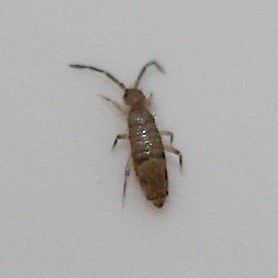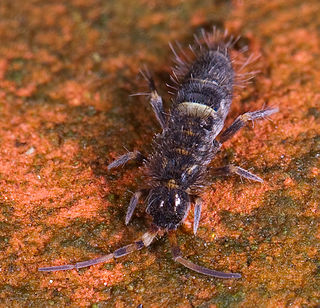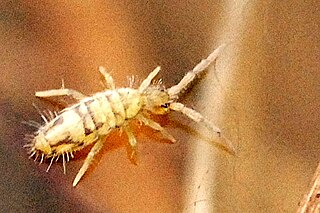
Entomobryidae, sometimes called "slender springtails", is a family of springtails characterised by having an enlarged fourth abdominal segment and a well-developed furcula. Species in this family may be heavily scaled and can be very colourful. The scale-less Entomobryidae are commonly caught in pitfall traps around the planet, and also occur in canopy faunas high up in trees. There are more than 1700 described species in Entomobryidae.

The Entomobryoidea are a superfamily of springtails (Collembola), tiny hexapods related to insects. In the modern sense, this group is placed in an order called Entomobryomorpha.

Springtails form the largest of the three lineages of modern hexapods that are no longer considered insects. Although the three orders are sometimes grouped together in a class called Entognatha because they have internal mouthparts, they do not appear to be any more closely related to one another than they are to all insects, which have external mouthparts.

Willowsia is a genus of slender springtails in the family Entomobryidae. There are about six described species in Willowsia.

Homidia sauteri is a species of slender springtail in the family Entomobryidae.
Homidia tiantaiensis is a species of slender springtail in the family Entomobryidae. It can be found in China. It has been known to feed on Pleurotus ostreatus.
Orchesella albosa is a species of slender springtail in the family Entomobryidae.
Orchesella fishmani is a species of slender springtail in the family Entomobryidae.
Orchesella hexfasciata is a species of slender springtail in the family Entomobryidae.
Orchesella melitensis is a species of slender springtail in the family Entomobryidae.
Orchesella pannonica is a species of slender springtail in the family Entomobryidae. It can be found in Romania, Austria, Hungary, and Yugoslavia.
Orchesella spectabilis is a species of slender springtail in the family Entomobryidae. It is found in Europe.
Orchesella texensis is a species of slender springtail in the family Entomobryidae.
Orchesella zebra is a species of slender springtail in the family Entomobryidae.

Orchesella villosa is a species of slender springtail in the family Entomobryidae. It is found in Europe, and is an invasive species in North America.
Pseudosinella spinosa is a species of slender springtails in the family Entomobryidae.

Entomobrya unostrigata, the cotton springtail, is a species of slender springtails in the family Entomobryidae.

Willowsia platani is a species of slender springtail in the family Entomobryidae. It is found in Europe.

Entomobrya nivalis, the cosmopolitan springtail, is a species of slender springtails in the family Entomobryidae.

Entomobrya atrocincta is a species of slender springtails in the family Entomobryidae. They display notable sexual dimorphism, rare in springtails, with the males being a vivid orange, and the females being a duller tan.








